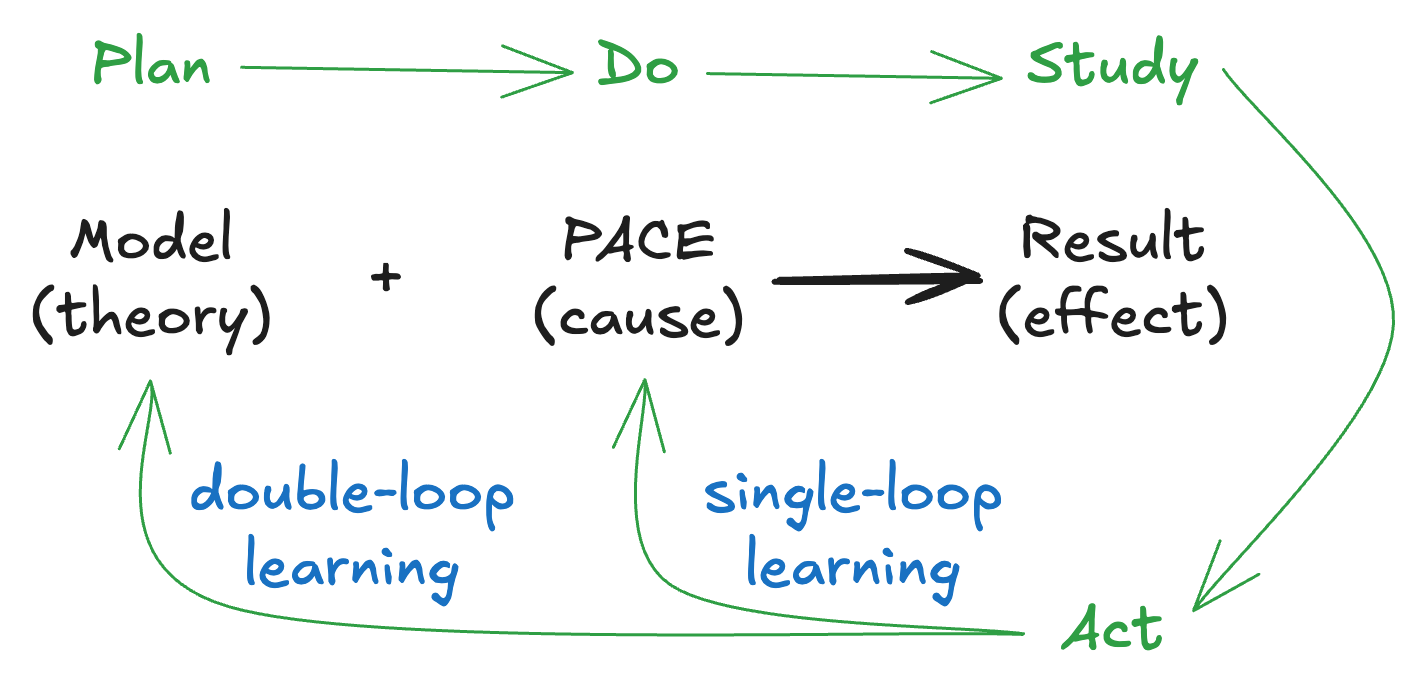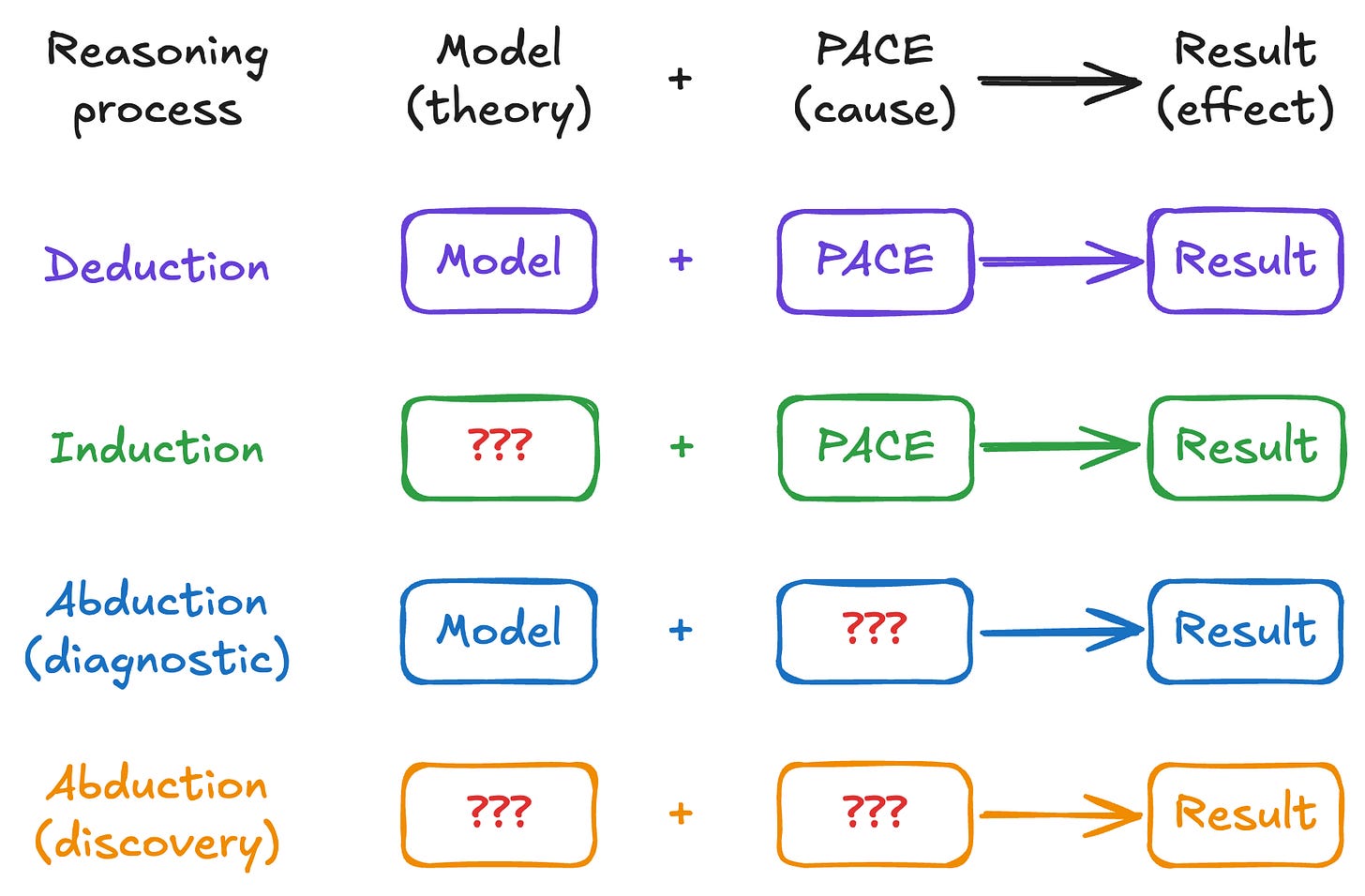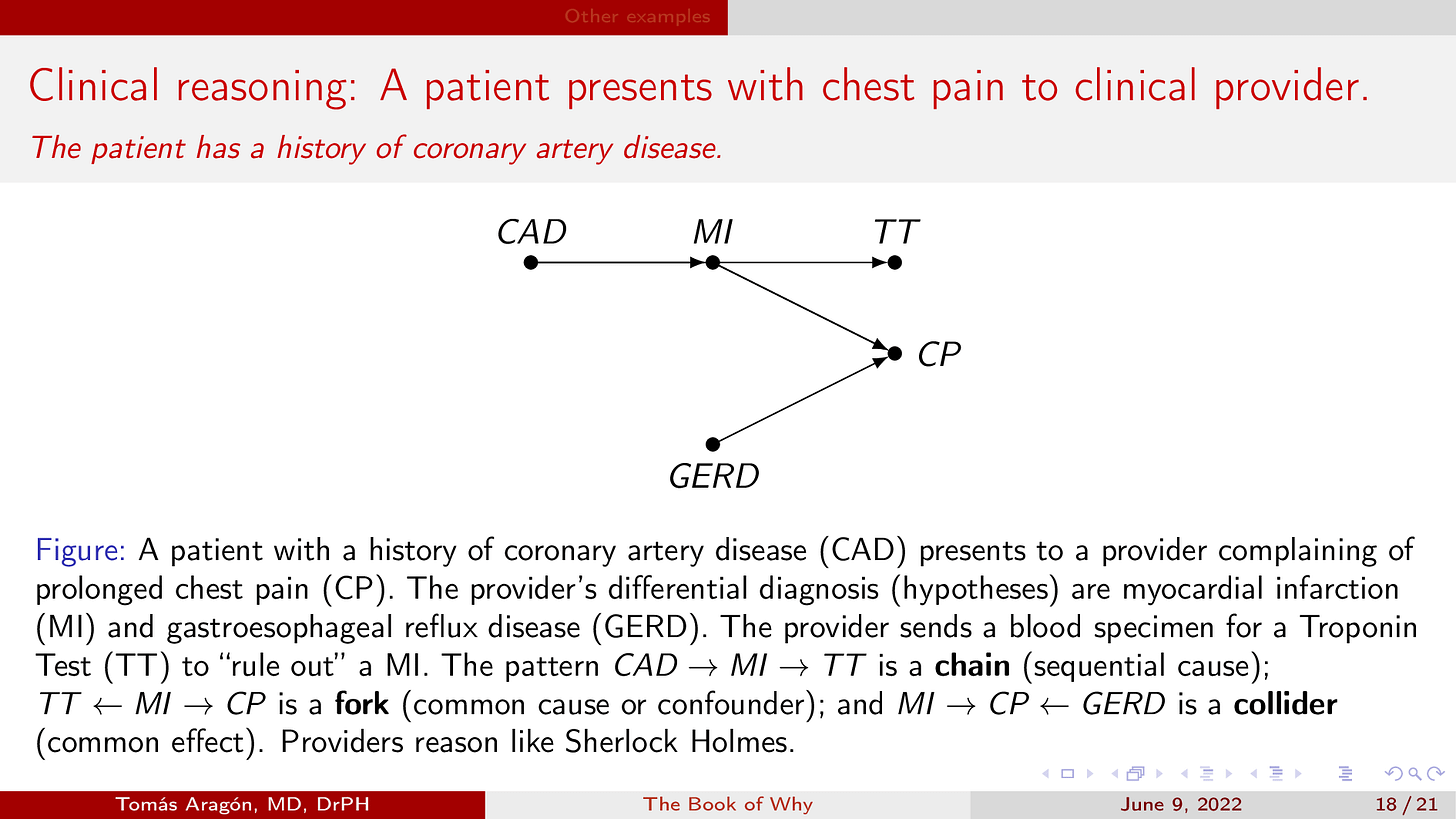PDSA thinking for daily problem-solving
Plan-Do-Study-Act for double-loop learning and scientific reasoning
Most of us are familiar with the Plan-Do-Study-Act (PDSA) cycle for testing, spreading, and sustaining improvement ideas.1 2 3 PDSA was popularized by W. Edwards Deming. The PDSA cycle is useful beyond improvement projects. PDSA thinking is how to deploy scientific thinking to solve any problem or embrace any opportunity. The purpose of this blog entry to convince you to embrace and apply PDSA thinking. We will start with improvement and then move to learning and reasoning.
From The Deming Institute:
“The PDSA Cycle (Plan-Do-Study-Act) is a systematic process for gaining valuable learning and knowledge for the continual improvement of a product, process, or service. …”
“The cycle begins with the Plan step. This involves
identifying a goal or purpose,
formulating a theory,
defining success metrics … .
These activities are followed by the Do step, in which the components of the plan are implemented, such as making a product. Next comes the Study step, where outcomes are monitored to test the validity of the plan for signs of progress and success, or problems and areas for improvement. The Act step closes the cycle, integrating the learning generated by the entire process, which can be used to adjust the goal, change methods, reformulate a theory altogether, or broaden the learning – improvement cycle from a small-scale experiment to a larger implementation Plan. These four steps can be repeated over and over as part of a never-ending cycle of continual learning and improvement.”
NOTE: Using OKR terminology, a goal is an Objective and metrics are Key Results. I review these important topics in Why leaders embrace OKRs -- and you should too. For understanding theory (models) see Program theory is for the DAGs .
PDSA versus PDCA
I notice some lean practitioners use PDCA or Plan-Do-Check-Act. I only use PDSA and here is why: From The Deming Institute:
“Dr. Deming emphasized the PDSA Cycle, not the PDCA Cycle, with a third step emphasis on Study (S), not Check (C). Dr. Deming found that the focus on Check is more about the implementation of a change, with success or failure. His focus was on
predicting the results of an improvement effort,
studying the actual results, and
comparing them to possibly revise the theory (see double-loop learning).
He stressed that the need to develop new knowledge, from learning, is always guided by a theory. By comparison, the Check phase of the PDCA cycle focuses on the success or failure of a Plan, followed by needed corrections to the Plan in the event of failure.”
To learn the history of PDSA and PDCA read “Circling Back: Clearing Up Myths about the Deming Cycle and Seeing How It Keeps Evolving.”4
BIG TIP: Learning requires prediction! Prediction error is the discrepancy between the results you predicted and the actual results. Understanding this gap leads to learning, and can be used to adjust and try again.
Double-loop learning
Let’s review so far. For PDSA thinking,
What is your Objective? Is it improvement, learning or both?
What does your Objective apply to? Is it theory, process, or results?
Improvements usually come from deploying established knowledge (ie, knowledge deployment of evidence or expertise). Improvements are focused on improving processes alone (eg, eliminating waste in lean), or improving processes to improve results (eg, Key Results that contribute to an Objective in OKRs).
Learning is often directed to knowledge discovery — generating new understandings about a theory, a process, or a result that can be generalized to other settings. Learning can occur without any improvements. Learning alone can be a valid goal.
However, in public health, we ultimately want to improve results (also called performance improvements) by improving processes and/or improving theory.
Improving processes often lead to incremental improvements in results (ie, kaizen in lean)
Improving a theory can sometimes lead to breakthrough improvement in results (ie, kaikaku in lean)
Incremental performance improvements occur by improving processes. Processes have underlying cause-effect assumptions called theories. The typical approach is to use PDSA cycles to test and adjust process improvements. We plan to test a process innovation, we make a prediction and test (do) the process innovation, we study the results, and we act on what we learned. This leads to incremental process improvements. Figure 2 depicts the relationship between a theory (model), a cause (process, action, condition, exposure), and an effect (result; ie, output or outcome).

Chris Argyris called this single-loop learning.5 6 He recognized that PDSA can also be used for double-loop learning which can lead to new theories and breakthrough performance improvements. Figure 3 depicts PDSA with single-loop and double-loop learning. For example, when efforts to improve a process are failing (unsatisfactory results), we have two choices:
continue attempts to improve the process (single-loop learning; possible incremental improvements), or
consider improving the theory (double-loop learning; possible breakthrough improvements)

Double-loop learning makes these possibilities explicit and encourages innovative (breakthrough) thinking. We aspire to be creative PDSA problem-solvers where expressing, challenging, and testing underlying assumptions (theories) is second nature.
Figure 4 depicts a well-known, historical example of single and double-loop learning with Olympic high jump performances.7 Single-loop learning led to incremental improvements during the “Scissors” era. However, when a new theory of high jumping emerged (i.e., “Western Roll”), we witnessed breakthrough improvements, followed again by incremental improvements until new theories emerged (“Straddle,” “Fossbury Flop”). Double-loop learning is powerful but requires awareness of its availability.
Deductive, inductive, and abductive reasoning
We can generalize our PDSA approach with deductive, inductive, and abductive reasoning. Figure 5 displays the Reasoning Matrix which consists of deduction, induction, and abduction applied to the causal framework that includes a theory (model), a cause (PACE = process, action, condition, exposure), and an effect (result; ie, output or outcome).

Single-loop learning involves a deductive reasoning process where we use a theory (causal assumption based on evidence, best practice, or personal expertise or experience) to implement a process to achieve a result. This translation of evidence into practice is the domain of implementation and improvement sciences.
Double-loop learning involves an inductive reasoning process to test a new theory (causal model). This can lead to new generalizable knowledge and maybe even breakthrough innovations. Think of computational deep neural networks that have enabled the field of generative artificial intelligence.
Most of us are familiar with deductive reasoning for knowledge deployment and with inductive reasoning for knowledge discovery. However, many of us are not familiar with abductive reasoning even though it is a foundational process of human cognition,8 and doctors use abduction to make a differential diagnosis.9 When we observe an effect we care about (eg, an outbreak), we ask what are the most likely causes and how do we sort this out? This reasoning process is abduction, and it’s necessary for tackling real world situations we face. Abductive reasoning is the basis of generating causal hypotheses.10
Abductive reasoning occurs in clinical medicine. When a doctor interviews a patient with chest pain (ie, effect, result, evidence), the doctor is trying to determine what is the most likely cause (process, action, condition, exposure; ie, hypothesis) from a list of probable causes based on the doctor’s expertise and experience (ie, causal models accumulated over time). Doctor’s are able to see many patients quickly because they have accumulated and deployed many causal models (knowledge).
Abductive reasoning is also called diagnostic or evidential reasoning. Figure 6 is an example of abductive reasoning from a slide presentation I created for a causal inference book club. The causal graph is the operational model (theory) for the clinical provider.

As human beings, our brains deploy abduction to predict the causes of the sensory input we are receiving from the external environment (exteroception) and from our bodies (interoception). Our brains use our memories and causal models we have accumulated over a lifetime, including recent experiences (recency bias).
Sometimes, we do not have a valid model (theory) to guide us. If we do not recognize this, our brains will draw their own conclusions anyway and they will very likely be wrong! We saw this with COVID-19 mis/disinformation and conspiracy theories.
A current example of abductive reasoning without widely established causes and theory is with the impact of social media and smartphones on youth mental health.11 The incidence of anxiety, depression, self harm, and suicides have increased in recent years (results, effects). There is intense debate on what are the most likely causes (processes, actions, conditions, exposures). However, we do not have a comprehensive causal framework (theory) to process and test competing hypotheses. Figure 7 is my first attempt to construct a causal model.

Summary
PDSA thinking is very powerful and includes
What is your Objective? Is it improvement, learning or both?
What does your Objective apply to? Is it
theory: model,
causes: actions, processes, or exposures, and/or
effects: results?
Understanding learning
single-loop learning for incremental improvements (eg, kaizen), and
double-loop learning for breakthrough improvements (eg, kaikaku)
Understanding reasoning processes:
deduction (knowledge deployment: applying evidence and evaluating implementation)
induction (knowledge discovery: generating and testing new theories)
abduction (hypothesis generation: regarding causes and theories)
“most likely cause” reasoning (which cause is most probable)
“explaining away” reasoning (rule out some of the causes)
common effects in causal graphs (ie, colliders)
generating new causal models (hypotheses) for testing
Appendix: Design thinking and Lean startup
PDSA thinking for daily problem solving is a universal, versatile framework; it aligns with very well with other popular frameworks such as design thinking (human-centered design) and lean startup (Table 1).
Footnotes
Christoff, Patricia. “Running PDSA Cycles.” Current Problems in Pediatric and Adolescent Health Care 48, no. 8 (August 2018): 198–201. https://doi.org/10.1016/j.cppeds.2018.08.006.
Taylor, Michael J, Chris McNicholas, Chris Nicolay, Ara Darzi, Derek Bell, and Julie E Reed. “Systematic Review of the Application of the Plan–Do–Study–Act Method to Improve Quality in Healthcare.” BMJ Quality & Safety 23, no. 4 (April 2014): 290–98. https://doi.org/10.1136/bmjqs-2013-001862.
Leis, Jerome A, and Kaveh G Shojania. “A Primer on PDSA: Executing Plan–Do–Study–Act Cycles in Practice, Not Just in Name.” BMJ Quality & Safety 26, no. 7 (July 2017): 572–77. https://doi.org/10.1136/bmjqs-2016-006245.
Ronald D. Moen and Clifford L. Norman. “Circling Back: Clearing Up Myths about the Deming Cycle and Seeing How It Keeps Evolving.” Quality Progress, November 2010.
Chris Argyris. “Double Loop Learning in Organizations.” Harvard Business Review, September 1977. https://hbr.org/1977/09/double-loop-learning-in-organizations.
Chris Argyris. “Teaching Smart People How to Learn.” Harvard Business Review, May 19, 2008. https://hbr.org/1991/05/teaching-smart-people-how-to-learn.
Vijay Govindarajan and Chris Trimble. “The CEO’s Role in Business Model Reinvention.” Harvard Business Review, January 2011. https://hbr.org/2011/01/the-ceos-role-in-business-model-reinvention.
Magnani, Lorenzo, ed. Handbook of Abductive Cognition. Springer Nature Reference. Cham, Switzerland: Springer, 2023.
Sooknanan, Joanna, and Terence Seemungal. “Not so Elementary - the Reasoning behind a Medical Diagnosis.” MedEdPublish (2016) 8 (2019): 234. https://doi.org/10.15694/mep.2019.000234.1.
Veen, Mario. “Creative Leaps in Theory: The Might of Abduction.” Advances in Health Sciences Education: Theory and Practice 26, no. 3 (August 2021): 1173–83. https://doi.org/10.1007/s10459-021-10057-8.
Haidt, Jonathan. The Anxious Generation: How the Great Rewiring of Childhood Is Causing an Epidemic of Mental Illness. New York: Penguin Press, 2024. https://www.anxiousgeneration.com/book.





